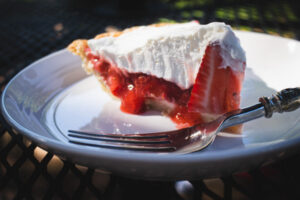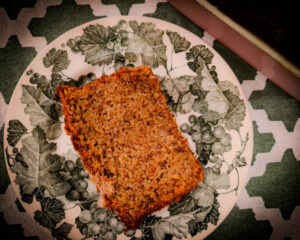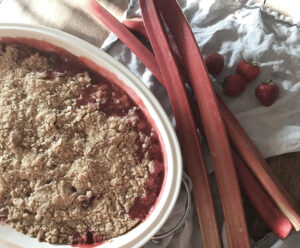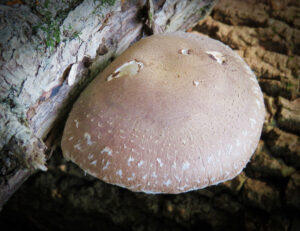Homemade Cream Cheese Will Follow When Yogurt Leads the Whey
A Dairy Daisy Chain

Mrs. April Jaure

I didn’t use to be “crunchy.” I preferred boxed mac and cheese made with neon orange powder to the real homemade version. Etcetera. I know; I know. The only excuse I can give is that I was younger than twenty-five, so my prefrontal cortex was not yet fully formed.
In my mid-twenties, I gave birth for the first time and nursed my daughter. Being so in awe at the power of nature and how well-ordered it was, I started exhibiting other crunchy behaviors, such as wearing my daughter in a sling and buying cloth diapers. Then I started eating more whole foods, then making my own natural household cleaners. One thing just sort of led to another. Before I knew it here I was, fourteen years later, spending my time cooking, baking, sewing, homeschooling my children (some of them attended by midwives during birth), and making my own yogurt and other fermented foods. I mean, who am I? But all these things have been strangely satisfying — fulfilling actually — and they are grounding and empowering when the world seems out of control. So I just continue ever deeper down this wonderful rabbit hole. Hello, prefrontal cortex.
I’d like to share with you my tutorial for making your own yogurt and other lovely foods derived therefrom. But beware: It might become one of those gateway crunchy behaviors that lead to others, such as canning, raising poultry, brewing kombucha, or making your own laundry soap. If you’re not careful, you could end up buying a homestead one day. But, if you are okay with these incumbent risks, please read on.
Yogurt is positively easy to make and has become a staple food for my family. We try to always have some on hand to eat as a filling for crepes, as a healthy snack, as a topping for fruit, or to use in Chicken Tikka Masala, my favorite Indian dish. It takes just a few minutes of active work to make, and in exchange it adds wonderful nutrition to a great variety of dishes.
And once you make yogurt, you can quickly make cream cheese, and then use the leftover whey to soak your grains and ferment your vegetables, and even make Scandinavian whey cheese. You see, making yogurt is not only a gateway addiction, it’s actually the first link in a convenient daisy chain of dairy productivity. Also, the benefits of making your own yogurt are numerous. For instance, homemade yogurt can be fermented for a longer time than store-bought. Many store brands ferment their milk for a mere four hours and use thickeners and fillers to give it a creamy texture. A longer fermentation time will yield higher probiotic content, and more difficult-to-digest casein protein will be predigested for you.
There are various yogurt types, and my husband and I have tried many methods over the years, but I will share our latest greatest. Yogurt requires only two ingredients: milk and a starter culture. Better ingredients will make a better yogurt. Therefore I recommend beginning with organic whole milk that is not ultra-pasteurized. We use a mesophilic starter culture, which allows the yogurt to ferment at a lower temperature than the alternative thermophilic culture. I used to have to put our milk in a picnic cooler wrapped in a heating pad in order to make yogurt, but with a mesophilic starter we can let the jar sit right on our countertop. (We purchase this from a small, online shop, which specializes in starter cultures for fermented foods.)
Below is the full scoop. Enjoy the rabbit hole
— April
Five Recipes

Mesophilic Yogurt
What You Need
Ingredients:
• Pasteurized whole milk
• Starter culture
Materials:
• Nut milk bag
• 2 cups of milk
• 1/2 gallon mason jar
• 2 pint mason jars
• Large bowl
What You Do
1.The first time you make yogurt, simply place two cups of pasteurized milk in a jar and mix in the starter culture. Put the lid on the jar and let sit on your countertop in a warm place (70° – 77° F).
2. After 12 hours, check to see if the yogurt has set. Simply tilt the jar slightly to see if it has thickened. It might be runny this first go-round, but if it has a pleasant, tangy scent, it can be used to make more yogurt.
3. After this first batch, you can make yogurt using half a gallon of milk. Simply pour your milk into a large mason jar and place four tablespoons of the first batch in the milk and stir. Put on the lid and place in a warm spot for twenty-four to forty-eight hours. You can check the consistency every few hours by tilting the jar and seeing if the yogurt pulls away from the side in one glob. We often leave our yogurt on the counter for twenty-four to forty-eight hours. It may take two or three batches for the consistency and flavor to even out.
4. If, after twenty-four hours you would like to thicken it up a bit, remove some whey by placing the yogurt in a nut milk bag and hang it over a large bowl. We simply hang the bag from the knobs of one of our upper cabinets in our kitchen. Once the thickness is to our liking, we place the yogurt in a jar and store in the refrigerator. We sometimes put it in a blender to give it a creamier, smoother texture. We also place the whey in a jar and store it in the refrigerator. One-half gallon of milk will yield about one quart of yogurt and one quart of whey.
5. Remember to always reserve some yogurt to make your next batch. To make more yogurt, place four tablespoons of the old yogurt into the milk and stir. Let sit on the counter for about twenty-four hours. Drain, and store in the fridge.
Raw Milk Yogurt
If you wish, you can also make yogurt using raw milk. Raw milk is known to have wonderful health benefits but there can be risks, so if you use raw, it is important that the milk is from a source you trust. You should also be aware of the laws governing the sale of raw milk in your area. If using raw milk, a mesophilic culture has the added benefit of preserving the nutritional integrity of the milk, though the extra step of making a mother yogurt is required. All future batches of yogurt will be inoculated using the mother culture. This mother will need to be replenished occasionally.
To make the mother, heat two cups of raw milk to 180° F to pasteurize it. Cool to 70° – 77° F. Place in a mason jar and add the culture to the milk and stir. Leave on the counter for 12 hours. Once this mother smells pleasant and tangy, it can be used to make raw milk yogurt. You will place four tablespoons of the mother in one-half gallon of raw milk and stir. Let sit for twenty-four to forty-eight hours on the countertop. Drain the whey to thicken it and blend for a smoother texture if you wish, and it is ready to eat. More batches will be made from the mother. When the mother needs to be replenished, you will again heat the milk to 180° F to pasteurize it, then cool before adding some of the old mother to make the new.
Yogurt Cream Cheese
If you want cream cheese to add to a dessert, or to use on crackers or bagels, just drip the yogurt for a while longer, and if needed gently squeeze out the whey, so that the yogurt gets thick. Voila! It’s now a healthy, spreadable yogurt cheese, which you can use most anywhere you’d normally use the store-bought stuff in the silvery pouches. Stunningly simple, eh?
If you are a cream cheese purist, or wish to become one, note that to make a true cream cheese, rennet would need to be used to culture some more of the fat. Mark it for later in your trek down the rabbit hole.
Whey
Our foremothers and fathers knew the importance of consuming large amounts of fermented foods. Plant-based foods contain wonderful nutrition, but the problem is that the human digestive system is not very good at extracting all their nutrients for our use. Fermenting foods unlocks these nutrients and populates our guts with beneficial bacteria. Whey is full of the wonderful bacteria that our digestive systems need to keep our gut healthy. A tablespoon or two of whey can be added to warm bowls of soup for added flavor and to add probiotics. When I make salsa, I add a couple of tablespoons of whey and let it sit on the counter for two days before refrigerating it, so that I have a probiotic and slightly fermented salsa. In my house, we soak nearly all grains overnight before cooking them. Although soaking in water is better than not soaking grains at all, if you can add a splash of whey to the water, it will be even better as the bacteria will begin to predigest these foods for you.
Mysost Cheese
If you are feeling adventurous, you can try a type of Scandinavian whey cheese called mysost. I find that the cheese tastes similar to parmesan. To make mysost, put a gallon of whey in a pot and boil it. Turn it down to a simmer for several hours, stirring occasionally. If you begin with a gallon of whey, you can simmer it overnight, but be careful with the timing because once most of the liquid is gone and it starts to thicken, you will need to stir it constantly to prevent it from burning and sticking to the pan. Once it thickens it will turn caramel in color and like gooey caramel in texture. Cool it down by placing the pan in cold water. Once cool you can transfer the mysost to a container and refrigerate it. Buttering the container will make the cheese easier to remove. One gallon of whey makes about one cup of mysost. A variation is to add a small amount of cream, up to a cup if using a gallon of whey, while simmering for a sweeter-tasting mysost.



















